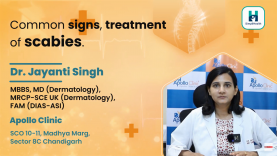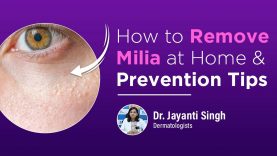Dr. Jayanti Singh
Dr. Jayanti Singh
Melasma : Causes and treatment
In this video Dr. Jayanti Singh, Consultant Dermatologist discusses common causes of Melasma and how we can prevent it.
What is melasma?
It is the leading cause of hyperpigmentation and mainly occurs in intensive sun-exposed areas. They may be in light brownish or dark brown or bluish-grey pigmentation on the face. Subsequently, hyperpigmentation may occur on both sides of the face symmetrically but mainly in the cheeks, forehead, mandibles, and nose. Depending upon the layer at which the pigmentation is present, one can categorize it into an epidermal, dermal, or mixed pattern. It is a multifactorial disease. It involves genetics and hormonal levels combined with exposure to UV radiation.
Why does melasma affect females more?
Most commonly, female hormones are responsible for 50% of this problem. There has been a direct relationship between melasma and female hormones, which is why it is more commonly present in females than males. In addition, 15-50% of hyperpigmentation starts during pregnancy. Therefore, fluctuation in the levels of estrogen and progesterone in the body plays a vital role.
Other reasons
Apart from pregnancy, other conditions involving hormonal fluctuations, like the use of oral contraceptives or ovarian dysfunction, can be the cause of hyperpigmentation in females. Apart from hormonal change, those with a family history of hyperpigmentation are 48% more likely to have it than others. In addition, certain cosmetics, photosynthesizing medications, and certain other medications can also be the reason.
What leads to melanin production?
On exposure to UV irradiation, all these reasons lead to the formation of reactive oxygen species that lead to stimulation in the production of pigment-forming cells or melanocytes. As a result, it increases the production of melanin. Ultimately this excessive melanin starts depositing in the skin and is seen as hyperpigmentation. Furthermore, prolonged and intensive sunlight exposure may precipitate melanin production and worsen it. Last but not least, stress is also one of its most critical factors. It initiates the production of melanocytes stimulating hormones, thereby increasing melanin production.
Treatment
The most important thing for its treatment is sun protection. One must opt for a broad-spectrum sunscreen, preferably a physical sunscreen. In addition, one must wear physical sun protection like hats, wear full sleeves clothes and try to stay in shady places. Certain creams are available with kojic acid or hydrocortisone, azelaic acid, vitamin C and arbutin-containing creams. One can combine creams with oral medicines. Oral medication involves. Tranexamic acid (TXA), glutathione vitamin C-containing tablets, and tablets with beneficial antioxidants. There is the production of reactive oxygen species on exposure to UV radiation. Certain antioxidant foods may help reduce it—Vitamin C-enriched foods like lemon, oranges, citrus fruits, Brockley, and sprouts.
Other procedures:
In addition to traditional medication, viz. creams and medicines, specific procedures like chemical peeling, micro-needling or dermabrasion, and platelet-rich plasma therapy can be helpful. It is not cancerous, and neither is it painful. But its treatment lasts long for those patients where pigmentation is deep-seated. So it becomes resistant to the treatment.
For more information, visit the clinic and follow SimpliHealth for more details. Stay healthy, stay happy.















Comments (0)